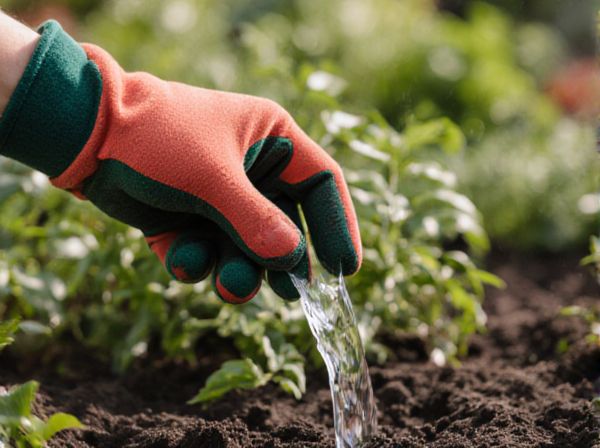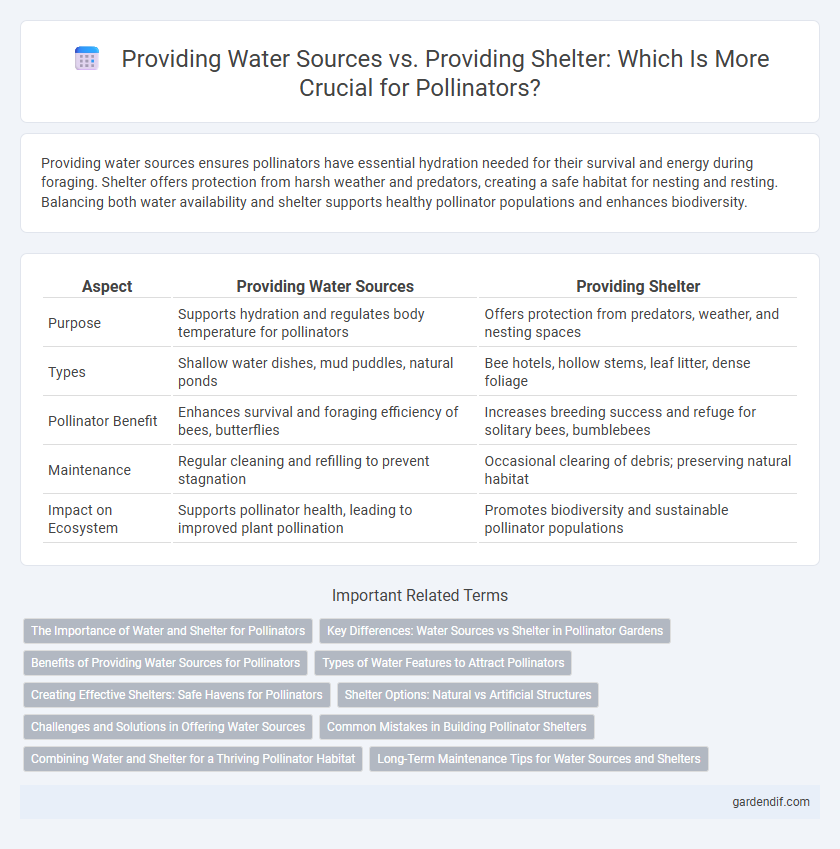
Providing water sources vs Providing shelter Illustration
Providing water sources ensures pollinators have essential hydration needed for their survival and energy during foraging. Shelter offers protection from harsh weather and predators, creating a safe habitat for nesting and resting. Balancing both water availability and shelter supports healthy pollinator populations and enhances biodiversity.
Table of Comparison
| Aspect | Providing Water Sources | Providing Shelter |
|---|---|---|
| Purpose | Supports hydration and regulates body temperature for pollinators | Offers protection from predators, weather, and nesting spaces |
| Types | Shallow water dishes, mud puddles, natural ponds | Bee hotels, hollow stems, leaf litter, dense foliage |
| Pollinator Benefit | Enhances survival and foraging efficiency of bees, butterflies | Increases breeding success and refuge for solitary bees, bumblebees |
| Maintenance | Regular cleaning and refilling to prevent stagnation | Occasional clearing of debris; preserving natural habitat |
| Impact on Ecosystem | Supports pollinator health, leading to improved plant pollination | Promotes biodiversity and sustainable pollinator populations |
The Importance of Water and Shelter for Pollinators
Water sources are essential for pollinators like bees and butterflies to regulate their body temperature and dilute nectar, supporting overall health and foraging efficiency. Providing adequate shelter, such as dense vegetation or nesting sites, offers protection from predators and harsh weather, ensuring pollinator survival and reproductive success. Together, water and shelter create a sustainable habitat that boosts pollinator populations and enhances pollination services in ecosystems.
Key Differences: Water Sources vs Shelter in Pollinator Gardens
Water sources in pollinator gardens primarily supply essential hydration, supporting bees, butterflies, and other insects in foraging and thermoregulation. Shelter offers protection from predators, harsh weather, and nesting spaces, crucial for reproduction and colony stability. Effective pollinator gardens balance both elements to enhance habitat suitability and promote pollinator health and diversity.
Benefits of Providing Water Sources for Pollinators
Providing water sources for pollinators supports hydration critical for their survival and enhances their ability to forage efficiently. Accessible water helps regulate pollinator body temperature and facilitates nutrient digestion, directly boosting pollination effectiveness. Strategically placed water features also attract diverse species, promoting ecosystem biodiversity and stability.
Types of Water Features to Attract Pollinators
Creating diverse water features such as shallow basins, mud puddles, and dripping water sources attracts a wide range of pollinators by fulfilling their hydration and mineral needs. Incorporating flat stones or gravel near water provides safe landing spots for bees and butterflies, enhancing accessibility. These water elements complement natural shelter options, optimizing habitat conditions to support pollinator health and biodiversity.
Creating Effective Shelters: Safe Havens for Pollinators
Creating effective shelters for pollinators involves designing protected habitats that offer safety from predators and harsh weather conditions, essential for their survival and thriving. Incorporating native plants, hollow stems, and undisturbed soil patches supports diverse pollinator species by providing nesting and breeding sites. Such shelters enhance pollinator populations, directly benefiting ecosystem services like pollination and biodiversity maintenance.
Shelter Options: Natural vs Artificial Structures
Providing shelter for pollinators involves choosing between natural habitats such as hollow stems, leaf litter, and tree bark, and artificial structures like bee hotels and nesting boxes engineered for solitary bees. Natural shelters offer biodiversity benefits by supporting various species and maintaining ecosystem balance, while artificial structures can be strategically placed to enhance pollinator presence in urban or agricultural settings. Both options improve pollinator survival and productivity by offering protection from predators and harsh environmental conditions.
Challenges and Solutions in Offering Water Sources
Providing water sources for pollinators poses challenges such as preventing drowning hazards and avoiding contamination from stagnant water. Solutions include installing shallow dishes with pebbles or floating materials to offer safe landing spots and regularly refreshing water to maintain cleanliness. Ensuring accessible and clean water supports pollinator health and enhances their activity in gardens and agricultural settings.
Common Mistakes in Building Pollinator Shelters
Providing water sources for pollinators is essential, but common mistakes in building pollinator shelters include using inappropriate materials that retain moisture, creating habitats prone to mold and predators. Shelters lacking proper ventilation or placed in unsuitable locations can deter pollinator use and reduce effectiveness. Opting for natural, dry, and well-ventilated structures improves shelter success compared to solely focusing on water availability.
Combining Water and Shelter for a Thriving Pollinator Habitat
Combining water sources and shelter creates an ideal environment for pollinators by meeting their essential survival needs. Access to fresh water supports hydration and nutrient intake, while sheltered areas protect pollinators from harsh weather and predators, enhancing habitat sustainability. Integrating both elements promotes biodiversity and increases pollinator activity and reproductive success in gardens and natural ecosystems.
Long-Term Maintenance Tips for Water Sources and Shelters
Maintaining clean, shallow water sources free from algae and debris ensures pollinators have safe hydration throughout the seasons, while regularly inspecting and repairing shelters prevents structural damage and promotes insect habitation. Using materials resistant to weathering and positioning shelters in sheltered, dry locations reduces long-term upkeep efforts. Seasonal monitoring and organic cleaning of both water features and nesting sites enhance pollinator survival and ecosystem stability.
Providing water sources vs Providing shelter Infographic

 gardendif.com
gardendif.com